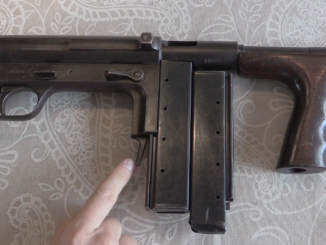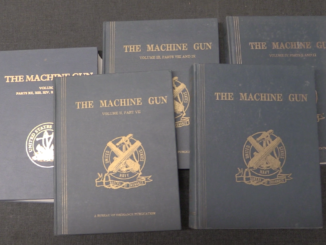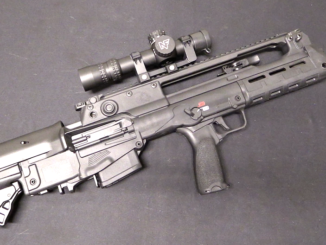This pistol sold for $2,300 at Rock Island on November 30, 2018.
Guncrafter Industries is a custom handgun company formed by one Alex Zimmerman in 2002 after many years working for Wilson Combat. Among other things, they make custom 1911 pistols chambered for the .50 GI (Guncrafter Industries) cartridge, also designed by Zimmerman. The idea of the cartridge is to have a larger bullet diameter without having the excessive power and recoil of a magnum type round like the .50 Action Express or .45 Winchester Magnum. The .50GI is loaded to .45 ACP pressure levels, and offers loadings ranging from 185gr @ 1200fps to 300gr @ 700 fps. The case head is rebated, and the same size as the .45ACP case head, allowing for easy conversion back to .45 ACP if one desires.
The basic conceit of this pistol and cartridge is that a larger bullet is more effective and thus worth the less of capacity (.50GI magazines hold 7 rounds). Whether that actually stands up to reality does not seem assured, especially considering the vast amount of development which has gone into smaller caliber expanding bullets compared to the few basic offerings for the .50 caliber.
Of course, it’s also possible that the gun is just simply based on the giggle factor of having a fifty caliber 1911.




Like the .45 GAP, the .50 GI may also have been intended for sale in countries that prohibit civilian ownership of “military caliber” weapons, which .45 ACP still is in some places, notably South America. In this sense, the name “.50 GI” could also be seen as something of a sarcastic comment on such laws. (“Silly laws promote transparent evasions”- Col. Jeff Cooper.)
As for magazine capacity, all my .45 ACP 1911s always had seven-round magazines, so I don’t see the problem. Especially with the 185-gr. .50 load having an ME of 590 FPE, up in .357 Magnum territory.
cheers
eon
“which .45 ACP still is in some places, notably South America. In this sense”
Then .38 Super is working well, .50 GI might be the answer for places where maximal magazine capacity is limited.
A large caliber pistol is quite intimidating, which might end a potential fight before it starts. “Whatever you do, do not get shot!!”
I must be getting old, while cool, the idea of a .50 caliber 1911 pattern pistol doesn’t excite me much.
Doesn’t mean I wouldn’t enjoy shooting one, however.
Something doesn’t have to be rational to be enjoyable.
The disadvantage of an expanding handgun bullet is: bullet energy used to deform the bullet is energy lost for use against the target. I also can’t help but wonder if the larger entry wound from a .50 bullet would speed the process of bleeding out compared to a 9mm bullet.
.50 GI would benefit from a modern all-copper (or all-zinc?) non-expanding bullet, such as the Underwood ‘Extreme Defender’ bullet. It’s also fun to imagine the .50 GI with an explosive or incendiary bullet!
>>>bullet energy used to deform the bullet is energy lost for use against the target.
nope.
actio = reactio (newton’s 3rd law)
that thang desperately needs mother-of-pearl grips
https://www.thehighroad.org/index.php?threads/general-george-patton-and-mother-of-pearl-grips.312228/
The knockdown effect is generally a reflex action, combined with the shock to the victim’s pain receptors. You won’t see people getting flung across the room just from the impact momentum of a pistol bullet.
It would be amusing to observe a movie where the shooter suffered the logical Newtonian physical consequences of the projectile’s demonstrated effect on the screen…
Only way that would ever happen is if it were forced by some kind of “Real Physics Fidelity” thing like the old Hayes committee…
(Director) “I wanna see that bad guy over there get blown through the window and out into the street…”.
(Stunt coordinator/SFX guy, sucking teeth, looking off into space… ) “OK, but…”.
(Director) “Just make it happen…”.
(Propmaster) “You want a what?!?”.
(Actor) “What the hell is this?!?”.
(Stunt coordinator/SFX guy, soothingly…) “That’s the gun you have to carry and shoot to get the shot the director wants…”.
(Stunt man) “Oh, hell no…”.
Deadpool 2?
🙂
When muscles relax due to disconnection from the CNS, such as that caused by a spine hit above the T4 vertebrae or an actual brain hit, or if the entire system shuts down when the heart stops working (say from a slug right through a ventricle), either of which takes about 5 to 10 seconds on average, gravity takes over and the vic tends to fall straight down.
Depending on posture at the instant of cessation, they might fall backward, sideways or even forward.
Hollywood rarely gets it right. Although the old Western cliche’ of the bad guy shot in the heart dropping his Colt, clutching his chest, grimacing and collapsing is a moderately accurate depiction of a heart shot, which in some cases has gross motor/neural effects very like a heart stoppage from natural causes (“heart attack”).
Yes. Forensic types (like me) often find action movies almost amusing in how badly they misportray things like that.
cheers
eon
It is interesting to contemplate just what they would have to be using as a sidearm, in order to achieve the shown effects up on the screen. Some of the movies I have been forced to sit through for various reasons (I am not a movie kind of guy…) have shown things that more-or-less imply that the protagonist was carrying and shooting a Carl Gustav at the bad guys…
Hmmmm…..
I’ve put a 150gr .308 bullet through both lungs and both lower chambers of a roe deer’s heart. A roe is small. 40kg / under 100lb
I could poke my index finger right through the heart.
The deer didn’t know what had happened, it ran about 40 yards and didn’t start to stumble until about 40 seconds after the shot.
Velocity was about 2600 fps.
It didn’t hit any significant nerves.
I’m guessing that a movie that showed a realistic nerve hit (thrashing around like a rabbit, Then trying to crawl and crying for mother) wouldn’t get much in the way of TV revenues.
Just a very “CLEAN & SLICK LOOKS” non of the warnings and manufacturing logos al over the places just what is required and thats all soooo nice!!!
I just like that big hole in the end of the gun!
There’s not really that much difference. Under ATF regs, a “fifty caliber” has to be no larger than about .495 inch, otherwise it’s classed as a “destructive device” in the same category as a 20mm cannon or a 57mm or larger recoilless rifle. There are special waivers for things like .577 or .600 Nitro Express rifles, or the huge .950 JDJ rifles.
So, a “.50 GI” bore spec is actually about .493″, the same as a .50AE, .500 S&W, or etc. A .45 ACP checks in at .451″. That’s an .042″ difference, or about the thickness of a typical credit card.
BTW, in model building, I use Evergreen brand .040″ sheet styrene all the time, so I know what it looks like. To get the real effect, take a .45 slug, cut a strip of index card to wrap around it (.020″, the same thickness as some other Evergreen styrene I use a lot), and look at it next to a “plain” .45 bullet.
Not much difference, really.
cheers
eon
It is essentially almost the same as the difference between .32″ (8mm) and .357″ (9mm), or again between the latter and .40 (10mm), that is, about 1mm. Whether it matters or not in practice is a much wider discussion…
Strictly speaking, even the difference between .36 cal. and .44 cal. in the percussion revolver days wasn’t much to get excited about.
Everybody thought the .44 was a powerhouse, just like they thought the big British Adams DA revolver in .500 was a no-doubt “stopper”.
What they overlooked (or more likely just never knew to begin with)was that with black powder as a propellant, the upper limit on velocity out of a typical revolver barrel (6″ to 8″) with the relatively small (under 30 grain) powder charges those revolvers’ chambers could accommodate was about 700 F/S. Which meant that the .36’s 80 to 90-grain round ball was generating about 100 FPE; the .44’s 178 grain ball at the same velocity was good for about 190, about twice as much but still way below a modern .38 Special. Even the older .38 S&W was more powerful than either one, at about 210 FPE on average. The conical bullets in both calibers (120 grain and 216 grain respectively) were somewhat slower at the muzzle and finished up roughly equal to the same caliber round ball in muzzle energy.
As for the big .500 Adams, its 280 grain “semi-conical” bullet left the muzzle at 600 F/S for 220 FPE more or less. It was in other words about equal in power to the old .38 S&W.
Compared to all of the above, the first generation of metallic-cartridge revolver/rifle rounds were certifiable Magnums. The .45 Colt’s 255 grain slug at 850 was good for 400 FPE; the .44-40’s 216 grain at 970 was good for about 440. The reason? Right in the .44-40’s designation; 40 grains of black powder. The .45 Colt held 35 on average. They were less “pistol” cartridges than centerfire iterations of the early rimfire metallic-cartridge carbine rounds, like the .44 Henry, which BTW had exactly the same specs as the .44-40 WCF that succeeded it; 216-grain bullet, 40 grains of Rifle Fine black powder. Their greater power came from greater velocity, not greater bullet weight.
The first rule of firearm killing power is the same as the first rule of traffic safety; Speed Kills.
Once you do the math on the “powerful” small arms of yesteryear, you begin to understand why no actual pistolier believed in any such thing as a “one-shot stop”.
Especially with a “cap-and-ball” revolver, or anything else.
cheers
eon
“Whether it matters or not in practice is a much wider discussion…”
Long long time ago in end of 19th century two schools of thinking about handgun cartridge appeared: one said that you need heavy (and slow) bullet, one that you need high-velocity (and light) bullet. And then Hugh Gabbet-Fairfax concluded that best solution will be throwing heavy bullet at high velocity and thus MARS automatic pistol appeared: https://www.forgottenweapons.com/early-automatic-pistols/gabbett-fairfax-mars/
“first rule of firearm killing power is the same as the first rule of traffic safety; Speed Kills.”
Then the ultimate answer is probably FK Field Tactical
http://modernfirearms.net/en/handguns/handguns-en/czech-republic-semi-automatic-pistols/fk-field-tactical-eng/
With a heavy enough projectile, you’d have a fall back in case of malfunctions. Just throw a round at the Bad Guy.
Throw the actual cartridge itself? Sounds like the aftermath of a destroyer escort ramming a U-boat, where the escort’s gun crew threw spent shell casings (we’re talking about shells for the main gun) at the sub amongst other things like potatoes…
That doesn’t excite me that much. What would excite me is a .50 BMG 1911. The grips would be enormous but that would cool.
I think only the BFG could handle a 1911 shooting the BMG.
500 Linebaugh a true 510 caliber with a 485 grain sharps boolit is about all I can handle in a Ruger custom pistol made by John Linebaugh. Well I live in Alaska that’s why.
Not surprisingly, cal.45 gov’t pistol draws lots of interest in foreigners and immigrants and some probably try to make even more out of it.
And hard to argue with the fact, why not. I recall one engineer from Belarus, who had on his screensaver x-ray image of this symbol of “freedom & democracy”. His political views were accordingly right-right. Business owner was originally from Poland, he did not mind a bit. Some other places of employment they would tell him to take it out.
If anything impresses me from Model 1911 stable it is undoubtedly the P14 by Para-Ordnance.
http://modernfirearms.net/en/handguns/handguns-en/canada-semi-automatic-pistols/para-ordnance-p14-45-eng/
I was able to shoot the “dwarf” version and it was surprisingly manageable.
Just wait until you’re dragged into court! That thing was created as a gift for any and every prosecutor who wants to score political points with deep-pocketed anti-libertarians. “That monster wanted to be the first man to kill someone with that .50 hand-cannon!”
Forget it, the gun is too expensive for crime of that sort and ammunition likely costs hundreds of dollars per box. The argument of killing people with large caliber hand cannons would fall flat, since muzzle loader hunting rifles are much cheaper, have bore diameters greater than half an inch and they pack way more punch!
I have shot the .50 GI at a store grand opening. An impressive, soft shooting weapon. The company furnished 5 rounds of solid copper hollow points that were shown to open to an in wide perfect star.
Interestingly it looks that .50 GI is for .45 Auto like .40 S&W for 9×19 Parabellum, though .40 S&W is not rebated rim design as 9×19 Parabellum is tapered.
I bet you could use Nitinol in hollow points; its a metal that changes size/shape etc with heat.
Even in mechanical broadheads for arrows, this Ni-Ti stuff is seriously under used in guns; I came up with a whole list of potential gun applications for it as soon as a found out it existed. I am in no way an expert on it mind, but I get the basics and I think it is ace.
Who wants to hear a whole slew of potential applications, such as driving bands in artillerly shells, breach seals in artillerly guns and lots of other non artillerly related things. Hint! I.e. Say yes; and I’ll spool them off “new useful things, I reckon you’ll like” I am simply desperate to tell someone as it is taking up all my brains “ram” and I need to free up some rom… So to speak.
It is topical, hollow points vs .50 cal etc; in that I started a related topic.
I mean now I’ve started I’ll probaly just carry on anyway; I was just giving you advanced notice.